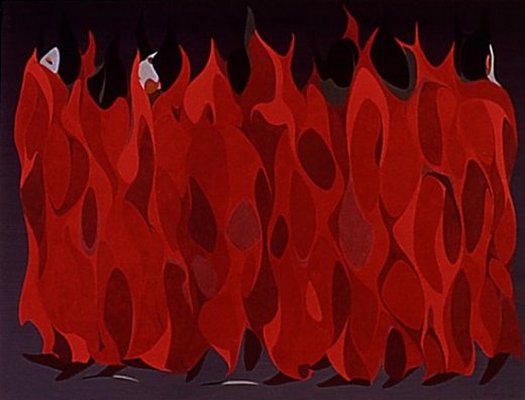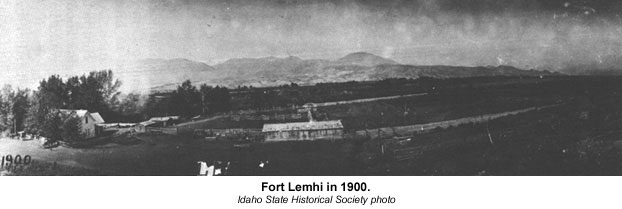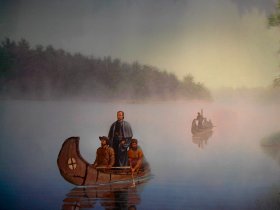|
|
Canku Ota |
|
|
(Many Paths) |
||
|
An Online Newsletter Celebrating Native America |
||
|
May 4, 2002 - Issue 60 |
||
|
|
||
|
This Date In |
||
|
North American Indian History |
||
|
from On This Date in North American Indian History at http://americanindian.net |
||
| May 4, 1863: | After the Minnesota uprising of the Santee Sioux, and their subsequent defeat, their lands are forfeited. The surviving Indians, including those who opposed the uprising and helped the whites, are ordered to be shipped to a reservation in Dakota Territory. 770 Santee Sioux board a steamboat in St. Paul for the journey west. Eventually 1,300 Santee Sioux are transported to an area which can hardly support life. During the first year, 300 Santee die. |
|
|
|
| May 5, 1763: | Near Fort Detroit, Ottawa Chief Pontiac addresses a group of Huron, Ottawa, and Potawatomi warriors. He asks them to join him in his fight against the British. |
|
|
|
| May 6, 1822: | As of today, all nonprofit government trading houses are closed on or near Indian lands. All future trading posts are commercial enterprises. |
|
|
|
 Oscar Howe's painting, Ghost Dance, depicts the Native American "Ghost Dance" religion which gained a huge following toward the end of the 19th century. |
|
| May 7, 1973: | According to the FBI, at 10:19 A.M. this morning, the occupation of Wounded Knee ended. The occupation started on February 27, 1973. |
|
|
|
| May 8, 1820: | The Mi’kmaq Acadia First Nation reserve of Gold River is established in Nova Scotia. The Shubenacadie First Nation reserve of Indian Brook #14 is also set up. |
|
|
|
| May 9, 1885: | Today through the 12th, events in the Second Riel Rebellion take place in Canada. Major General Frederick Middleton and a force of 800 soldiers attack the Metis and Cree holding the village of Batoche. The fighting continues through the 12th until the soldiers finally overrun Batoche. |
|
|
|
| May 10, 1832: |
Settlers start construction of what is called Fort Blue Mounds, near modern Madison, Wisconsin, the fort is built to protect the settlers from attacks by the Winnebagos. |
|
|
|
| May 11, 1974: | The Acting Deputy Commissioner of Indian Affairs has authorized an election for amendments to the Constitution and By-Laws of the Lac Courte Oreilles Band of Lake Superior Chippewa Indians of Wisconsin. The amendments are voted in. |
|
|
|
| May 12, 1860: |
A battle in the Paiute War takes place in Nevada at Big Bend in the valley of the Truckee River. Major William Ormsby’s Nevada militia are attacked by Paiutes under war Chief Numaga. |
|
|
|
| May 13, 1614: | The Viceroy of Mexico finds Spanish Explorer Juan de Oñate guilty of atrocities against the Indians of New Mexico. As a part of his punishment, he is banned from entering New Mexico again. |
|
|
|

|
|
| May 14, 1880: | Lemhi Chief Tendoy and several others sign an agreement to leave the Lemhi Reservation in Idaho. The agree to go to Fort Hall. It will be nine years before Congress approves the agreement. The Lemhi will not actually move until 1909. |
|
|
|
| May 15, 1846: | A treaty is signed by Texas Governor Pierce Butler, and Colonel M.G. Lewis (Meriwether Lewis' brother), and sixty-three Indians of the Aionai, Anadarko, Caddo, Comanche, Kichai (Keehy), Lepan (Apache), Longwha, Tahuacarro (Tahwacarro), Tonkawa, Waco, Wichita and tribes. It is ratified on February 15, 1847, and signed by President Polk on March 8, 1847. |
|
|
|
| May 16, 1677: | Mugg, an Arosaguntacook Indian Chief, dies in Black Point, Maine. At the outset of King Philip's war, Mugg attempted to arrange a peace treaty with the British. Instead they jail him for a short time, and gain a bitter enemy. He destroys much of Black Point, Maine in a raid on October 12, 1676. Later he captures a few ships and stages a brief naval war before his death. |
|
|
|
 Jacques Marquette, a French missionary who was a member of an European expedition led by Louis Joliet. In 1673, Marquette and Joliet traveled down the Mississippi River as far as the Arkansas River. |
|
| May 17, 1673: | Father Jacques Marquette and Louis Joilet begin their expedition from the "Straights of Michilimackinac." Eventually, they explore much of the Mississippi River. |
|
|
|
|
For Information on This Date in Canada visit our friends at: |
|
Canadian
Aboriginal News |
|
|
||
|
|
||
| Canku Ota is a free Newsletter celebrating Native America, its traditions and accomplishments . We do not provide subscriber or visitor names to anyone. Some articles presented in Canku Ota may contain copyright material. We have received appropriate permissions for republishing any articles. Material appearing here is distributed without profit or monetary gain to those who have expressed an interest. This is in accordance with Title 17 U.S.C. section 107. | ||
|
Canku Ota is a copyright © 2000, 2001, 2002 of Vicki Lockard and Paul Barry. |
||
|
|
|
|
|
The "Canku Ota - A Newsletter Celebrating Native America" web site and its design is the |
||
|
Copyright © 1999, 2000, 2001, 2002 of Paul C. Barry. |
||
|
All Rights Reserved. |
||
